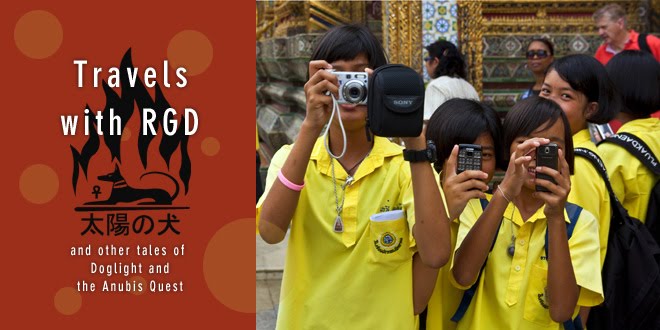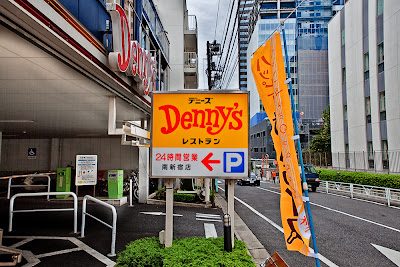(Tip: Click on photos to see a larger version or go to www.ronalddunlapphotography.com)
All marterials including photographs are ©2011 Ronald Gary Dunlap / Doglight Studios.
All rights reserved.
After my usual morning routine, I boarded a northbound train for Akihabara, famous for its conglomeration of electronic, Manga and anime shops. The 411 on Akihabara is that it's the ultimate place for Tokyo's legions of geeks and devotees of fantasy and role-playing to get their weekly fix of what's new.
During the ride to Akihabara, I took what I believe to be the best shot of the trip. The handsome, well dress executive seems worn out by the travails of the day, with his young competition coming up fast outside the window.
That left only the commercial establishments to provide me with something interesting to experience. Manga is big here, but of limited interest to me. All the character figures, compelling as they are, are a little bit outside my taste level and my pocketbook.
This place is a little like the old Radio Shack, lots of non-name-brand items but nothing really new or impressive. I'd read in several guides that companies come here to test new products, but I wasn't able to find anything that I hadn't seen before. I wandered around for hours trying to find something I hadn't seen before, but no luck.
I visited Yodobashi Camera, which is the large camera chain in Japan. Several guidebooks, including A Geek in Japan, expressed the idea that cameras were cheaper here, but that has not been my experience. Everything I priced was at least 30% higher here than I could get it for in Los Angeles. And they didn't have international warranties. I thought my experience in Shinjuku might just be because of the area, but Akihabara is supposed to be discount heaven, and I wasn't able to find even a hint of that promised land. Getting bored, I headed back to the train and my next stop, Ginza.
The Ginza is Tokyo's high-tone shopping area. In the old days, Ginza meant something like "large silver mint," and the shops here seem so enamored of the name that they are continuing the tradition by mining the silver from pockets of their customers. I love the area's detail. The attention paid to the smallest utilitarian items is staggering. The doors to these fuel-access ports are raised above the norm by their spot-on reverence to the gods of correct proportions and superior craftsmanship.
The major players are all here, from Gucci to Tiffany to Apple. I read that before the earthquake of 2010, Japan was the destination for over 40% of the world's luxury goods; and even during this time of uncertainty for the Japanese people, they still lust after high-end name-brand goods. That's why spotting a shopgirl in $2,000 Gucci thigh-high boots is nothing special. You've got to have lots of financial resources to keep up with the Satos (Japan's equivalent of the American Jones) here. But it's different from the high-end shopping in Hong Kong. A difference in tone, something about the Japanese preference for understated, refined beauty, seems to make it a lot less flashy than Hong Kong.
Over the past few days I must have walked 8 or 9 miles a day, and I was a little worn out. I stopped in at a local 7-Eleven to purchase an energy gel drink. They are very addictive; like a space food, the gel is sealed in a vacuum-sealed pouch. Once you break the seal, you begin to suck out the gel and continue sucking until the pouch is flat and you have gotten every delicious droplet of gel down your throat. I don't know why they aren't available in the United States. They must be some vitamin-stuffed form of jellied sugar, but they're delicious.
I tried snapping some shots of the shoppers on the street, but they have a seventh sense, and just as I'm hitting the shutter button they turn away. I do get a restaurant worker to pose, and the back of a woman wearing a kimono. I grab some texture shots of the area and some of the window displays. Again, I find the attention to detail staggering. I am very envious. Everything in America these days is just basic, because everything is based on cost. We're making a giant mistake; the country is too divided to make attainable goals. A real shame.
Back in Shinjuku, I rest up in my room until the sun is down and then head back to the Metropolitan building for some night shots. I wait in line until I finally get my trip up.
Power conservation doesn't seem to be a concern to the persons in charge of the 52nd floor. The reflections are a hazard. I place the lens hood directly against the window, but because it's fluted I'm still getting errant light intruding into my composition. After giving up on a pristine shot, I begin to incorporate the reflections into my shots. I stay for 20 minutes and then head down.
Walking back, I pass through a section of restaurants and drinking establishments filled with company men totally committed to their nightly stress-relieving drinking ritual.










































































































